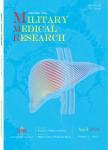Septic encephalopathy: When cytokines interact with acetylcholine in the brain
Septic encephalopathy: When cytokines interact with acetylcholine in the brain作者机构:Department of Microbiology and Immunology Burns Institute First Hospital Affiliated to the Chinese PLA General Hospital
出 版 物:《Journal of Medical Colleges of PLA(China)》 (中国人民解放军军医大学学报(英文版))
年 卷 期:2014年第29卷第2期
页 面:115-124页
学科分类:1002[医学-临床医学] 100204[医学-神经病学] 10[医学]
基 金:supported by National Natural Science Foundation of China (81272089, 81130035, 81372054, and 81121004) the National Basic Research Program of China (2012CB518102) the "Twelve-Five Plan" for Military Scientific Foundation (BWS12J050)
主 题:septic encephalopathy acetylcholine neuroinflammation cholinergic anti-inflammatory pathway delirium immunosuppression
摘 要:Sepsis-associated encephalopathy(SAE) is a brain dysfunction that occurs secondary to infection in the bo characterized by alteration of consciousness, ranging from delirium to coma, seizure or focal neurological signs. S involves a number of mechanisms, including neuroinflammation, in which the interaction between cytokines a acetylcholine results in neuronal loss and alterations in cholinergic signaling. Moreover, the interaction also occurs the periphery, accelerating a type of immunosuppressive state. Although its diagnosis is not specific in biochemis and imaging tests, it could potentiate severe outcomes, including increased mortality, cognitive decline, progress immunosuppression, cholinergic anti-inflammatory deficiency, and even metabolic and hydroelectrolyte imbalan Therefore, the bilateral communication between SAE and the multiple peripheral organs and especially the immu system should be emphasized in sepsis management.



